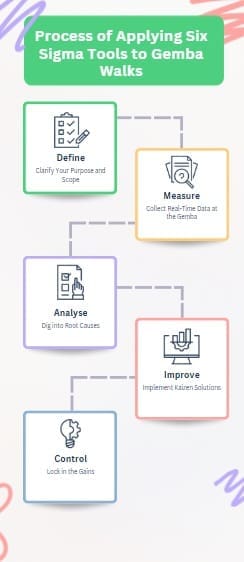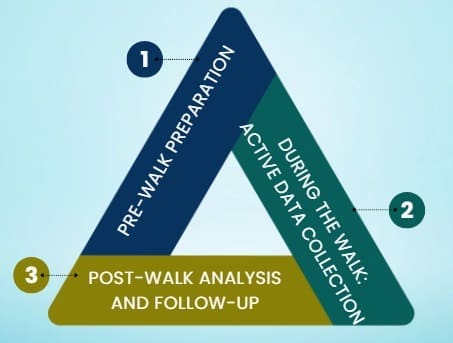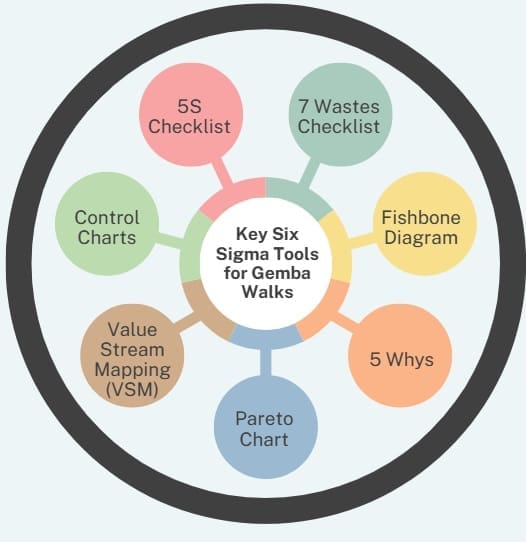Gemba walks, rooted in Lean principles, encourage leaders to engage directly with frontline workers to spot inefficiencies like bottlenecks or waste. Six Sigma, with its DMAIC framework, adds a layer of analytical depth to turn observations into measurable gains. Whether you’re in manufacturing, healthcare, or services, this integration can slash defects, boost quality, and foster a culture of Kaizen—continuous small improvements.
The integration of Six Sigma tools into gemba walks represents more than just a process improvement technique—it’s a strategic methodology that empowers leaders to make data-driven decisions while maintaining direct connection with frontline operations.
This powerful combination enables organizations to bridge the gap between statistical analysis and real-world application, creating sustainable improvements that resonate throughout the entire value stream.
Let’s dive into how to make this synergy work, step by step, with tools like SIPOC, Pareto charts, and 5 Whys to guide your journey.
Table of contents
What are Gemba Walks and Why pair them with Six Sigma?
Gemba walks invite leaders to the frontline—where value is created. The term “Gemba,” Japanese for “the actual place,” emphasizes observing processes in their natural environment. Unlike desk-bound analysis, Gemba walks reveal real-time truths: a machine that jams, a nurse delayed by paperwork, or a call center agent navigating outdated systems. By engaging with workers respectfully, leaders uncover insights that reports often miss, fostering trust and collaboration.
Six Sigma, pioneered by Motorola, aims for near-perfect quality, targeting fewer than 3.4 defects per million opportunities. Its DMAIC cycle (Define, Measure, Analyze, Improve, Control) provides a structured path to reduce process variation. When paired with Gemba walks, Six Sigma transforms casual observations into data-driven solutions.
For example, spotting a delay during a walk is one thing; using Six Sigma tools to measure, analyze, and fix it ensures lasting impact. This combination aligns with Lean Six Sigma principles, merging waste elimination with variability reduction for operational excellence.
Studies show organizations using Lean Six Sigma with regular Gemba walks achieve up to 25% improvements in efficiency and 30% reductions in defects over time. By grounding Six Sigma’s analytics in Gemba’s real-world context, you create a cycle of continuous improvement that resonates across industries.
Public, Onsite, Virtual, and Online Six Sigma Certification Training!
- We are accredited by the IASSC.
- Live Public Training at 52 Sites.
- Live Virtual Training.
- Onsite Training (at your organization).
- Interactive Online (self-paced) training,
Process of Applying Six Sigma Tools to Gemba Walks

To harness this synergy, integrate Six Sigma’s DMAIC framework with Gemba walks. Here’s how to do it, with practical tools and tips for each phase.
Define: Clarify Your Purpose and Scope
Before stepping into the Gemba, set a clear goal. Are you tackling cycle time issues, quality defects, or safety concerns? Use a SIPOC diagram to map Suppliers, Inputs, Process, Outputs, and Customers, providing a high-level view of the process. For instance, in a warehouse, your SIPOC might show suppliers (vendors), inputs (raw materials), process (inventory handling), outputs (shipped goods), and customers (retailers).
This clarifies boundaries and aligns your walk with customer requirements.
Next, define Critical to Quality (CTQ) metrics using a CTQ tree. If reducing patient wait times in a hospital is the goal, CTQ metrics might include “time from arrival to triage” or “patient satisfaction scores.”
A clear charter with KPIs ensures your walk stays focused, avoiding aimless observation. Involve a cross-functional team—operators, supervisors, engineers, and even customers—using a RACI matrix (Responsible, Accountable, Consulted, Informed) to assign roles. A facilitator keeps the walk constructive, ensuring respectful dialogue.
Measure: Collect Real-Time Data at the Gemba
With your purpose defined, head to the Gemba armed with a checklist. A 5S checklist (Sort, Set in order, Shine, Standardize, Sustain) assesses workplace organization, while a 7 Wastes checklist (overproduction, inventory, motion, waiting, transportation, overprocessing, defects) spots inefficiencies. For example, during a factory walk, you might notice excessive motion due to poor tool placement.
Engage workers with open-ended questions: “Can you show me how you handle this step?” Collect data like cycle times, defect rates, or customer feedback using simple tools like stopwatches or tally sheets. In a call center, time how long agents take to resolve queries. Avoid assumptions—focus on observing and recording. A process map or Gemba board (a visual display of metrics) helps capture findings, making it easier to visualize workflows and pinpoint variations.
Also Read: Gemba Board
Analyze: Dig into Root Causes
Post-walk, analyze your data to uncover why problems occur. Use a fishbone diagram (Ishikawa) to categorize causes—people, processes, equipment, materials, environment, or systems. For instance, if a Gemba walk reveals inconsistent delivery times in logistics, ask “Why?” five times (the 5 Whys technique). This might lead from “late deliveries” to “truck scheduling issues” to “lack of real-time tracking.”
A Pareto chart prioritizes issues, showing that 80% of defects often stem from 20% of causes. In a retail setting, analyzing checkout delays might reveal that 70% come from scanner malfunctions. Control charts track process stability, highlighting variations needing attention. This phase bridges Gemba’s qualitative insights with Six Sigma’s quantitative rigor, ensuring you address root causes, not symptoms.
Improve: Implement Kaizen Solutions
Now, turn insights into action. Brainstorm solutions with your team, leveraging Kaizen for quick, incremental changes. In a manufacturing plant, if Gemba reveals cluttered workstations, apply 5S to reorganize tools, testing the change immediately. Poka-Yoke (error-proofing) can prevent mistakes—like color-coding parts to avoid assembly errors.
Pilot solutions on a small scale, measuring outcomes. A hospital might test a new triage checklist, reducing wait times by 15%. Involve frontline workers to ensure buy-in and feasibility. Document improvements using an action plan or Gantt chart to track progress, ensuring alignment with your KPIs.
Control: Lock in the Gains
Sustainability is key. Establish controls like dashboards or Gemba boards to monitor KPIs, such as defect rates or cycle times. Schedule follow-up walks to verify adherence. In a service firm, standardized scripts reduced escalations by 40%; control charts ensured consistency. Recognize team contributions to maintain morale and reinforce a Kaizen culture.
Use statistical process control (SPC) to detect variations early. Regular Gemba walks—weekly for leaders, daily for supervisors—keep improvements on track, embedding continuous improvement into daily operations.
Implementation Strategy

Pre-Walk Preparation
Successful integration of Six Sigma tools into gemba walks begins with thorough preparation. Review existing process data, control charts, and performance metrics before conducting walks. This background knowledge helps focus observations on critical areas and enables more meaningful discussions with employees.
Prepare data collection templates that incorporate Six Sigma measurement requirements. Design observation forms that capture both quantitative data points and qualitative insights, ensuring comprehensive documentation of improvement opportunities.
Furthermore, establish clear objectives and success criteria for each gemba walk. Define specific questions to investigate, processes to observe, and data points to collect, creating focused and productive observation sessions.
During the Walk: Active Data Collection
Implement systematic data collection procedures that capture both immediate observations and long-term trends. Use mobile devices or tablets to record real-time data, photos, and voice notes that support subsequent analysis activities.
Engage employees in meaningful conversations about process challenges, improvement ideas, and potential solutions. Document these insights alongside quantitative measurements to create comprehensive improvement opportunities.
Additionally, observe process variations, cycle time fluctuations, and quality issues that might not be apparent in aggregated data reports. These real-time observations provide valuable context for statistical analysis and improvement planning.
Post-Walk Analysis and Follow-up
Apply Six Sigma analytical tools to process gemba walk observations and measurements. Use statistical software to analyze collected data, identify patterns, and validate improvement hypotheses generated during observations.
Create action plans that combine statistical insights with practical observations from gemba walks. Prioritize improvements based on both quantitative impact assessments and qualitative feasibility considerations.
Implement control mechanisms that ensure sustained improvements over time. Establish regular gemba walk schedules that monitor implemented changes and identify new improvement opportunities as processes evolve.
Key Six Sigma Tools for Gemba Walks

Beyond DMAIC, specific tools enhance Gemba walks:
- 5S Checklist: Ensures a clean, organized workplace, making issues visible.
- 7 Wastes Checklist: Identifies inefficiencies like waiting or overproduction.
- Fishbone Diagram: Categorizes root causes for deeper analysis.
- 5 Whys: Drills down to the source of problems through iterative questioning.
- Pareto Chart: Prioritizes high-impact issues for focused improvement.
- Value Stream Mapping (VSM): Visualizes workflows to eliminate non-value-adding steps.
- Control Charts: Monitors process stability post-improvement.
For virtual Gemba walks (e.g., remote teams), adapt tools like digital VSM or video analysis to capture real-time insights. These instruments turn observations into actionable strategies, amplifying the impact of your walks.
Also Read: Visual Management: Definitions, Tools & Examples for Efficiency
Example
Consider Toyota, a Lean pioneer. Gemba walks paired with Six Sigma reduced weld imperfections on their assembly line. Leaders observed variations, used DMAIC to analyze tool wear, and implemented automated checks, cutting defects by 35%.
In healthcare, a hospital tackled ER overcrowding. Gemba walks revealed triage delays; a Pareto chart showed 60% stemmed from paperwork errors. After implementing digital forms and training (Improve phase), wait times dropped from 50 to 25 minutes, sustained via control charts.
A call center used Gemba walks to address long resolution times. Observing agents, they mapped processes, identified redundant steps with VSM, and introduced scripts, slashing escalations by 45%. These examples highlight how Six Sigma and Gemba walks drive results across industries.
Best Practices and Pitfalls to Avoid
Maximize your Gemba walks with these tips:
- Schedule Regularly: Weekly for managers, daily for supervisors.
- Stay Curious, Not Critical: Focus on processes, not people, to build trust.
- Document Immediately: Use Gemba boards or apps to capture real-time data.
- Involve Workers: Their insights ensure practical solutions.
Avoid common mistakes:
- Treating Walks as Inspections: This alienates teams and stifles collaboration.
- Ignoring Data: Balance observations with metrics for credibility.
- Skipping Follow-Ups: Without controls, improvements fade.
In diverse workplaces, adapt for cultural sensitivity, ensuring inclusivity. These practices embed Gemba walks into your culture, driving lasting change.
Final Words
Applying Six Sigma tools to Gemba walks is like giving your processes a superpower. By observing the real place, measuring performance, analyzing root causes, implementing Kaizen improvements, and controlling outcomes, you create a cycle of excellence. This approach doesn’t just fix problems—it builds a culture where everyone strives for better. From manufacturing floors to hospital wards, the Gemba-Six Sigma synergy delivers measurable gains in quality, efficiency, and engagement.
Start small: plan your first walk, grab a checklist, and go to the Gemba. With Six Sigma’s precision, you’ll turn observations into breakthroughs. Your journey to operational excellence begins today.
Frequently Asked Questions (FAQs) on Six Sigma Tools for Gemba Walks
How do Six Sigma tools enhance Gemba walks?
Six Sigma tools like DMAIC, Pareto charts, and 5 Whys add data-driven precision to Gemba observations, ensuring root causes are addressed for lasting improvements.
What’s the ideal frequency for Gemba walks in a Six Sigma project?
Conduct weekly walks during Define and Measure phases, scaling to bi-weekly in Control. Daily walks suit supervisors monitoring specific processes.
Can Gemba walks with Six Sigma work in service industries?
Yes! In call centers or retail, observe workflows, measure KPIs like resolution time, and apply DMAIC to reduce waste and boost customer satisfaction.
How does Kaizen fit into Gemba walks and Six Sigma?
Kaizen drives small, continuous improvements during the Improve phase, using Gemba insights and Six Sigma tools to refine processes collaboratively.
How do you measure success from a Gemba walk?
Track KPIs like defect rates, cycle times, or customer feedback before and after improvements, using control charts to ensure sustained results.

About Six Sigma Development Solutions, Inc.
Six Sigma Development Solutions, Inc. offers onsite, public, and virtual Lean Six Sigma certification training. We are an Accredited Training Organization by the IASSC (International Association of Six Sigma Certification). We offer Lean Six Sigma Green Belt, Black Belt, and Yellow Belt, as well as LEAN certifications.
Book a Call and Let us know how we can help meet your training needs.




















